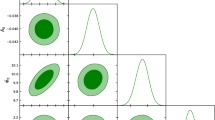Abstract
A version of the five-dimensional unified theory of gravitation, electromagnetism, and scalar field is developed. It is shown that in this theory the main features of Kaluza's five-dimensional theory and the Weyl one, based on non-Riemannian geometry and on conformal mapping, are combined. Some reasons are pointed out for choosing the physical 4-metric to be conformal (with the factorϕ 2=−G 55) to the 4-metric obtained by 1+4 splitting of the initial five-dimensional manifold. It is shown that the electrical charge and current appear in the geometrical theory if the condition of cylindrical symmetry in the fifth coordinate is substituted by the condition of quasicylindrical symmetry (i.e., the physical 4-metric and the vector potential of electromagnetic field remain independent of the fifth coordinate, while the scalar field depends on it). Two kinds of the most important exact solutions of the 15 field equations are considered. They are (1) static spherically symmetrical solutions and (2) homogeneous isotropic cosmological models.
Similar content being viewed by others
References
Einstein, A., and Bergmann, P. (1938).Ann. Math., ser. 2,39, 683.
Kaluza, T. (1921).Sitzungsber. Berl. Akad., 966.
Weyl, H. (1918).Sitzungsber. Berl. Akad., 465.
Vladimirov, Yu. S., and Antonov, V. I. (1977).Problems of the Theory of Gravitation and Elementary Particles, vol. 8, Atomizdat, Moscow, p. 162.
Einstein, A. (1927).Sitzungsber. Preuss. Akad. Wiss., Phys.-Math. Kl., 26.
Antonov, V. I., Efremov, V. N., and Vladimirov, Yu. S. (1978).Gen. Rel. Grav.,9,9.
Brans, C., and Dicke, R. H. (1961).Phys. Rev.,124, 925.
Einstein, A., and Rosen, N. (1935).Phys. Rev.,48, 73.
Hoyle, F., and Narlikar, J. V. (1964).Proc. R. Soc. London Ser. A,282, 191.
Scherrer, W. (1949).Helv. Phys. Acta,22, 537.
Kramer, D. (1971).Acta Phys. Polon.,B2, 807.
Lyogky, A. I. (1979).Problems of the Theory of Gravitation and Elementary Particles, vol. 10, Atomizdat, Moscow, p. 149.
Fisher, I. Z. (1948).Z. Eksp. Teor. Fiz.,18, 636.
Vladimirov, Yu. S., and Antonov, V. I. (1974).Vestnik Moskow. Univ. Ser. III, Fiz., Astron., Vol. 1, 54.
Einstein, A. (1922).Sitzungsber. Preuss. Akad. Wiss., Phys.-Math. Kl., 449.
Kottler, F. (1922).Enzykl. Math. Wiss.,22a, 231.
Friedmann, A. A., (1922).Z. Phys., 10, B6, 377.
de Sitter, W. (1917).Mon. Not. R. Astron. Soc.,78, 3.
Author information
Authors and Affiliations
Rights and permissions
About this article
Cite this article
Vladimirov, Y.S. The unified field theory, combining Kaluza's five-dimensional and Weyl's conformal theories. Gen Relat Gravit 14, 1167–1181 (1982). https://doi.org/10.1007/BF00762641
Received:
Issue Date:
DOI: https://doi.org/10.1007/BF00762641




